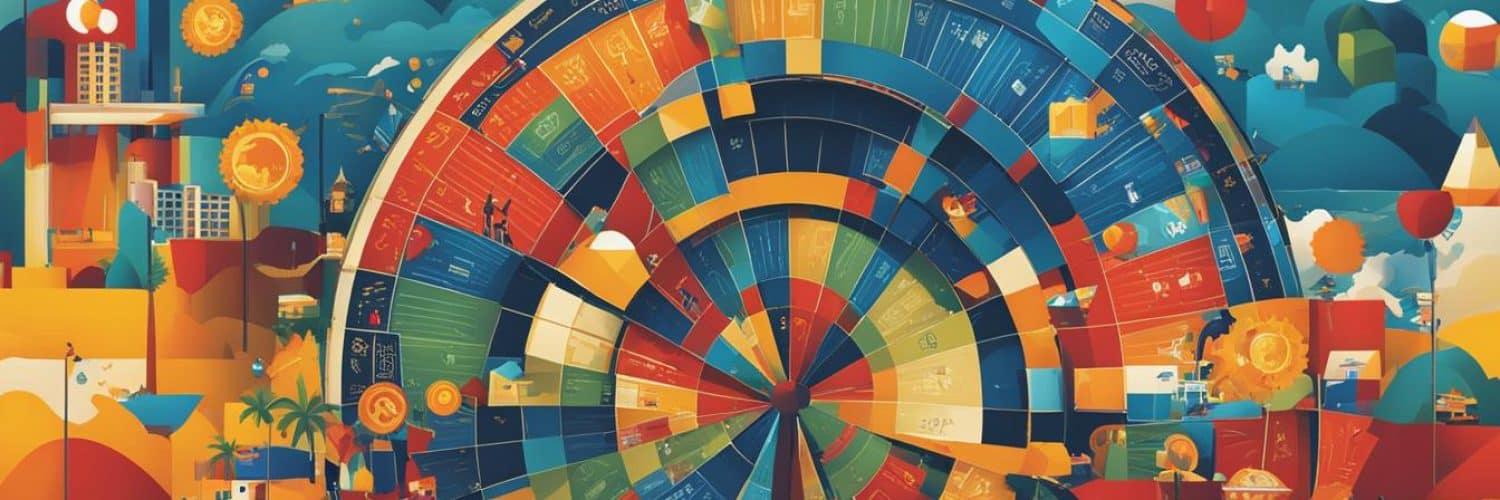Have you ever wondered what factors contribute to inflation in the Philippines? With rising prices impacting the economy and everyday life, understanding the causes of inflation is crucial. From supply and demand dynamics to government spending and economic structure, multiple factors play a role in driving inflation in the country.
Key Takeaways:
- Inflation in the Philippines is driven by factors such as supply and demand dynamics, government spending, and economic structure.
- Rising prices impact the economy and individuals in various ways, making it essential to understand the causes of inflation.
- Examining the impact of inflation on different sectors and vulnerable populations can help identify targeted solutions.
- Individuals and businesses can employ strategies like budgeting, emergency funds, and wise investments to cope with increasing inflation.
- Real estate investment can serve as a hedge against rising prices and contribute to financial stability.
Factors Driving Inflation in the Philippines
Inflation in the Philippines is influenced by various factors that contribute to the rising prices in the country. Understanding these causes is essential for economic analysis and developing strategies to address the issue.
- Supply and Demand: One of the primary drivers of inflation in the Philippines is the interplay between supply and demand. When the demand for goods outstrips the available supply, it leads to an increase in prices. This phenomenon, known as “demand-pull” inflation, can occur when consumer spending rises or when there are supply shortages in key sectors.
- Government Spending: Another significant factor driving inflation is government spending. When the government spends more than the economy’s productive capacity, it creates excess demand, leading to inflationary pressures. This type of inflation is referred to as “cost-push” inflation, as it is driven by higher costs imposed on businesses, which are then passed on to consumers.
- Supply Chain Disruptions: Supply chain disruptions can also contribute to inflation in the Philippines. When there are disruptions in the production and distribution of goods, it can lead to rapid price increases. This is particularly evident during times of natural disasters, political instability, or global crises, which impact the availability and cost of essential goods.
- Currency Devaluation: Currency devaluation can have inflationary effects by making imported goods more expensive. When the value of the Philippine peso depreciates against other currencies, it increases the prices of imported goods and raw materials. Ultimately, this cost is passed on to consumers, contributing to inflationary pressures.
These factors, including supply and demand dynamics, government spending, supply chain disruptions, and currency devaluation, collectively contribute to the inflationary environment in the Philippines. Analyzing and addressing these drivers are crucial for effective economic management and understanding the impact of rising prices on the economy and its citizens.
Impact of Imported Commodities on Inflation
The Philippines heavily relies on imported commodities like rice and energy inputs. When the global prices of these commodities increase, the Philippines has no choice but to pay more for them. This dependence on imports contributes to inflationary pressures in the country.
For example, in February 2023, the inflation rate on food items was 10.8 percent, and electricity and fuel inflation reached 8.6 percent. While these prices have started to come down in recent months, any further disruptions in the global supply chain could drive up prices again.
| Month | Food Inflation Rate | Electricity and Fuel Inflation Rate |
|---|---|---|
| February 2023 | 10.8% | 8.6% |
| March 2023 | 9.5% | 8.1% |
| April 2023 | 8.3% | 7.5% |
| May 2023 | 7.6% | 7.1% |
| June 2023 | 6.9% | 6.6% |
The rising prices of imported commodities have a direct impact on the cost of living for consumers. As the prices of essential goods and energy rise, households may have to allocate a larger portion of their budgets to cover these expenses. This can put a strain on their finances and lead to reduced purchasing power for discretionary spending.
In addition to imported commodities, the Philippines also faces inflationary pressures from factors such as supply and demand dynamics, government spending, and supply chain disruptions. It is crucial for policymakers to closely monitor these inflation drivers and implement appropriate measures to manage and stabilize prices in the economy.
Economic Structure and Inflation in the Philippines
The structure of the Philippines’ economy plays a significant role in understanding the inflationary pressures within the country. Unlike other Southeast Asian nations where the state absorbs some of the price increases through subsidies or interventions, certain sectors in the Philippines, such as electricity, operate in a market-driven environment. This means that consumers bear the direct cost of price increases, leading to additional challenges in managing inflation.
The market-driven nature of the Philippine economy exacerbates the economic issues related to inflation. With consumers directly impacted by price increases, it becomes crucial to closely analyze the inflation drivers in order to create effective economic policies and strategies. Through careful economic analysis, it is possible to identify the underlying factors contributing to inflation and develop appropriate countermeasures.
The Market-Driven Nature of the Philippine Economy
Unlike economies that receive government subsidies or interventions, the Philippine economy operates under a market-driven system. This means that price adjustments and the costs associated with those adjustments are directly borne by consumers. As a result, any inflation drivers within the economy have a direct and immediate impact on the cost of goods and services, affecting the purchasing power of individuals and businesses.
Providing an environment where market forces dictate prices has its benefits, but it also presents challenges in managing inflation, as price increases are felt more acutely by consumers. This market-driven structure requires a focused approach to economic analysis in order to identify and address the specific drivers of inflation.
Economic Analysis: Illuminating Inflation Drivers
In order to effectively manage inflation, a comprehensive economic analysis is necessary. This analysis involves examining a range of factors, including the cost-push and demand-pull drivers that contribute to price increases. By understanding the root causes of inflation, policymakers and economists can develop targeted strategies and implement appropriate monetary policies to maintain price stability.
It is crucial to conduct an in-depth economic analysis to identify the underlying economic issues that drive inflation in the Philippines. This involves examining various factors such as supply and demand dynamics, government spending patterns, the impact of imported commodities, and supply chain disruptions. By thoroughly analyzing these elements, it becomes easier to design effective policies and regulations that can mitigate inflationary pressures and ensure economic stability.
| Inflation Drivers | Description |
|---|---|
| Cost-Push Inflation | Occurs when increases in production costs, such as rising oil prices, lead to higher prices for goods and services. |
| Demand-Pull Inflation | Happens when consumer demand exceeds the available supply, resulting in upward pressure on prices. |
| Price of Imported Commodities | Dependence on imported commodities like rice and energy inputs can lead to inflationary pressures when global prices increase. |
| Supply Chain Disruptions | Disruptions in the global supply chain can lead to rapid price increases in the local market. |
Through comprehensive economic analysis, it becomes clear that addressing the unique economic issues driving inflation in the Philippines is crucial for long-term stability and growth. By understanding the market-driven nature of the country’s economy and conducting in-depth analysis, policymakers and stakeholders can take proactive measures to manage inflation effectively.

Inflation Forecast for the Philippines
The inflation rate in the Philippines is forecasted to average 4.4 percent in 2023, with a further decrease to 3.1 percent in 2024. While the cost of goods and services is expected to continue rising, the rate of increase is projected to be slower compared to previous years. This forecast takes into account the subdued economic activity and weak commodity prices, which are contributing factors to the relatively low inflation rate.
However, it is essential for businesses to remain vigilant and prepare for potential increases in inflation in the future. Rising prices can have a significant impact on operations, affecting profitability and purchasing power. By staying informed about economic trends and conducting thorough economic analyses, businesses can better navigate the challenges posed by inflation and minimize its potential impact.
Coping with Increasing Inflation
As inflation continues to impact economies, it is crucial for individuals and businesses to adopt strategies to cope with rising prices. By implementing these strategies, you can navigate the effects of inflation and safeguard your financial stability.
1. Careful Budgeting and Expense Tracking
To effectively manage your finances during periods of increasing inflation, it is essential to create and stick to a carefully planned budget. Track your expenses diligently and identify areas where you can make adjustments to minimize costs. By monitoring and controlling your spending, you can mitigate the impact of rising prices.
2. Creating an Emergency Fund
Unforeseen expenses can arise during times of inflation, making it critical to have an emergency fund in place. Set aside a portion of your income regularly to build a financial safety net that can cushion you against unexpected financial burdens. An emergency fund provides peace of mind and acts as a buffer to navigate through challenging economic times.
3. Exploring Additional Sources of Income
With inflation eroding purchasing power, it may be necessary to seek additional sources of income to bolster your financial resilience. Consider taking up freelance work, starting a side business, or investing in income-generating opportunities. Diversifying your income streams can help counterbalance the impact of rising prices and provide financial stability.
4. Wise Investments, such as Real Estate
Investing in assets that can withstand inflationary pressures is crucial. Real estate, for example, is often considered a reliable investment during periods of rising prices. Properties tend to appreciate over time, providing a potential hedge against inflation. Additionally, rental income from real estate can provide a steady cash flow, helping to offset the effects of increasing prices.
| Strategies for Coping with Increasing Inflation |
|---|
| Careful budgeting and expense tracking |
| Creating an emergency fund |
| Exploring additional sources of income |
| Wise investments, such as real estate |
By employing these strategies, you can navigate the challenges posed by rising prices and inflationary pressures. Take proactive measures to protect your finances and secure a stable future.

Inflation’s Impact on the Poor
Inflation can have a significant impact on the poor and those below the poverty line in the Philippines. The rising prices of goods and services can make it even more difficult for low-income earners to meet their basic needs. This can result in compromises in essential goods and services, including healthcare. It is important to address the effects of inflation on vulnerable populations and implement measures to mitigate its impact.
| Impact of Inflation on the Poor | Consequences |
|---|---|
| Higher Cost of Living | Inflation leads to increased prices of essential goods and services. For the poor, this means they need to spend a larger portion of their income on basic necessities, leaving less room for savings or discretionary spending. |
| Reduced Access to Healthcare | With rising prices, healthcare services become more expensive. This can prevent low-income individuals from seeking necessary medical care, leading to compromised health outcomes and exacerbating existing health inequalities. |
| Food Insecurity | Inflation can result in higher food prices, making it more challenging for the poor to afford nutritious meals. This can contribute to food insecurity and malnutrition among vulnerable populations, particularly children. |
| Education Affordability | As prices rise, the cost of education, including school fees, textbooks, and supplies, also increases. For low-income families, this can make access to quality education more difficult, perpetuating the cycle of poverty. |
| Increased Income Inequality | Inflation tends to affect lower-income households disproportionately. As the prices of goods and services rise, those with higher incomes may be better equipped to absorb the additional costs, further widening the income gap. |
To mitigate the impact of inflation on the poor, it is crucial to implement targeted policies and measures. These may include:
- Providing social safety nets and direct assistance programs to support low-income households.
- Investing in education and skill development initiatives to empower individuals from disadvantaged backgrounds.
- Improving healthcare services and affordability to ensure equitable access to medical care.
- Promoting inclusive economic growth and addressing structural inequalities to reduce poverty and enhance upward mobility.
“Addressing the effects of inflation on the poor requires a comprehensive approach that tackles both immediate needs and underlying systemic issues. By implementing targeted policies and programs, we can strive towards a society where the most vulnerable are protected and have equal opportunities for a better future.”
Understanding the Inflation Rate
The inflation rate is a crucial indicator of economic health as it measures the general increase in prices of goods and services over time. In the Philippines, the inflation rate reflects the decline in purchasing power as incomes struggle to keep up with rising prices. To track and analyze inflation, economists rely on two main indices: the Consumer Price Index (CPI) and the Wholesale Price Index (WPI).
The Consumer Price Index (CPI) is a key measure that examines the prices of consumer goods and services. It provides valuable insights into the cost of living and the impact of price changes on households. By monitoring changes in CPI, policymakers can assess the effects of inflation on the general population, adjust monetary policies, and make informed decisions to stabilize the economy.
The Wholesale Price Index (WPI) focuses on tracking price changes at the wholesale level. This index helps economists keep tabs on inflationary pressures throughout the supply chain, as it examines the prices of goods and services before they reach the retail market. Analyzing the WPI enables businesses and policymakers to identify potential cost increases, predict future price movements, and make strategic decisions to minimize adverse effects on the economy.
Inflation is like taxation without legislation. Milton Friedman
Understanding the inflation rate is pivotal in shaping economic analysis and forecasting future trends. By leveraging the CPI and WPI, individuals, businesses, and policymakers can gain valuable insights into the impact of rising prices on the overall economy and make informed decisions to mitigate the effects of inflation.
| Data | Consumer Price Index (CPI) | Wholesale Price Index (WPI) |
|---|---|---|
| Definition | A measure of changes in retail prices of a basket of goods and services. | A measure of changes in wholesale prices of goods produced and sold in bulk. |
| Data Source | National Statistics Office (NSO) or Bangko Sentral ng Pilipinas (BSP) | Bangko Sentral ng Pilipinas (BSP) |
| Target Audience | Households, individuals, policymakers | Businesses, economists, policymakers |
| Scope | Consumer goods and services | Wholesale goods and bulk sales |
By closely monitoring the inflation rate through the CPI and WPI, stakeholders can formulate effective strategies to navigate the challenges posed by rising prices and mitigate the economic impact of inflation.
Types of Inflation
Understanding the different types of inflation is crucial when analyzing the causes of inflation in the Philippines. Inflation can be classified into three main categories:
- Demand-Pull Inflation: This type of inflation occurs when consumer demand exceeds the production capacity, causing prices to rise. Increased consumer spending, often fueled by economic growth or expansionary monetary policies, leads to a higher demand for goods and services, which outpaces the supply available. As a result, prices increase in response to the imbalance between supply and demand.
- Cost-Push Inflation: Cost-push inflation is driven by increased production costs. Factors such as rising energy prices, higher wages, or increased taxes can raise the overall cost of production for businesses. To maintain their profit margins, businesses then pass on these increased costs to consumers, resulting in higher prices for goods and services.
- Built-In Inflation: Built-in inflation occurs when wages increase to keep up with the rising costs of living. When individuals and workers expect inflation to continue, they demand higher wages to maintain their purchasing power. However, these wage increases ultimately contribute to higher production costs for businesses, leading to a cycle of ongoing price increases.
By understanding these types of inflation, policymakers and economists can assess the specific inflation drivers in the Philippines and develop informed strategies to address rising prices.
Pros and Cons of Inflation
Inflation, as an economic phenomenon, can have both positive and negative impacts on an economy. It is important to analyze the benefits and drawbacks to understand the overall implications of inflationary trends. Let’s explore the pros and cons of inflation.
Pros of Inflation
- Real Wage Adjustment: Inflation can lead to real wage adjustment, where wages increase to keep up with rising prices. This ensures that workers’ purchasing power remains relatively stable.
- Price Adjustments: Inflation allows for price adjustments to reflect the actual costs of goods and services. This ensures that producers can cover their expenses and maintain profitability.
- Healthy Economy Indicator: Moderate inflation is often seen as a sign of a healthy economy. It indicates that there is sufficient demand for goods and services, fosters economic growth, and encourages investment.
Cons of Inflation
- Reduced International Competitiveness: High levels of inflation can reduce a country’s international competitiveness. Rising prices make exports more expensive, leading to a decline in demand and potential loss of market share.
- Uncertainty: Inflation can create uncertainty in the economy, making it difficult for businesses and individuals to plan for the future. This can hinder long-term investment decisions and slow down economic growth.
- Lower Investment Rates: High inflation rates often lead to lower investment rates. Investors may be hesitant to allocate funds to long-term projects due to concerns about eroding purchasing power and unpredictable returns.
Striking a balance in managing inflation is crucial to mitigate its negative effects. Governments and central banks employ various monetary and fiscal policies to regulate inflation and maintain stability within the economy.

Managing Inflation through Real Estate Investment
During periods of inflation, real estate investment can be a smart strategy for individuals and businesses looking to mitigate the impact of rising prices. The value of real estate tends to appreciate during inflationary periods, offering property owners the opportunity to sell at higher prices and generate substantial returns on their investment.
Investing in real estate provides a tangible asset that can serve as a hedge against inflation. While other forms of investment may be negatively affected by inflation, such as stocks and bonds, real estate tends to maintain its value and even increase in worth. The demand for housing and commercial properties remains strong, making real estate a relatively secure investment option.
Furthermore, real estate investment can provide a steady stream of income through rental properties. As prices rise, rental rates also tend to increase, allowing property owners to benefit from higher rental income and offsetting the impact of inflation on their finances.
When considering real estate investment during inflationary periods, purchasing affordable properties such as house and lot options can be advantageous. These properties typically offer better long-term value appreciation and rental income potential compared to more expensive luxury properties. Adequate research and due diligence are essential to identify properties in emerging areas with attractive growth potential.
By strategically investing in real estate, individuals and businesses can navigate the challenges of inflation and protect their assets from the erosive effects of rising prices. Real estate offers a tangible and income-generating investment that can help preserve wealth and provide financial stability in an inflationary environment.
Conclusion
Inflation in the Philippines is a complex issue influenced by various factors. Supply and demand dynamics, government spending, supply chain disruptions, and the country’s reliance on imported commodities all contribute to rising prices. It is crucial for businesses and individuals to take proactive measures to cope with increasing inflation.
One effective strategy is careful budgeting, which allows for better management of finances during times of rising prices. Creating emergency funds can provide a safety net for unexpected expenses and economic uncertainties. Additionally, being prepared and exploring additional sources of income can help mitigate the impact of inflation on household budgets.
Wise investments, such as real estate, can also play a significant role in combating the effects of inflation. Investing in affordable properties, such as house and lot options, can provide a hedge against rising prices while contributing to long-term financial stability. Understanding the impact of inflation and taking appropriate measures is vital for both the economy and individual households in the Philippines.
FAQ
What are the causes of inflation in the Philippines?
What factors drive inflation in the Philippines?
How do imported commodities impact inflation in the Philippines?
How does the economic structure of the Philippines contribute to inflation?
What is the inflation forecast for the Philippines?
How can individuals and businesses cope with increasing inflation?
What is the impact of inflation on the poor in the Philippines?
How is the inflation rate measured in the Philippines?
What are the different types of inflation?
What are the pros and cons of inflation?
How can real estate investment help manage inflation?
What is the conclusion regarding the causes and impact of inflation in the Philippines?
Source Links
- https://thediplomat.com/2023/08/is-the-philippines-winning-its-battle-against-inflation/
- https://www.vistaresidences.com.ph/blog/inflation-meaning-what-triggers-rising-inflation-in-the-philippines
- https://www.lumina.com.ph/news-and-blogs/blogs/3-major-contributing-factors-for-inflation-rate-in-the-philippines/


















Add comment